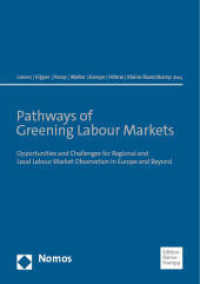- ホーム
- > 洋書
- > 英文書
- > Business / Economics
Full Description
The topic of organizational identity has been fast growing in management and organization studies in the last 20 years. Identity studies focus on how organizations define themselves and what they stand for in relation to both internal and external stakeholders. Organizational identity (OI) scholars study both how such self-definitions emerge and develop, as well as their implications for OI, leadership and change, among others.
We believe there are at least four inter-related reasons for the growing importance of OI. OI addresses essential questions of social existence by asking: Who are we and who are we becoming as a collective? It is a relational construct connecting concepts and ideas that are often viewed as oppositional, such as "us" and "them" or "similar" and "differen". OI is also nexus concept serving to gather multiple central constructs, also represented in this Handbook. Finally, OI is inherently useful, as knowing who you are is the foundation for being able to state what you stand for and what you are promising to others, no matter their relation with the organization.
The Handbook provides a road-map to the OI field organized in over 25 chapters across seven sections. Each chapter not only offers a broad overview of its particular topic, each also advances new knowledge and discusses the future of research in its area of focus.
Contents
Michael G.Pratt, Majken Schultz, Blake Ashforth, and Davide Ravasi: Organizational Identity: Mapping Where We Have Been, Where We Are, and Where We Might Go
Section 1: Mapping the organizational identity (OI) field
1: Peter Foreman and David Whetten: Great debates in organizational identity study
2: Dennis A. Gioia and Aimee L. Hamilton: Measuring organizational identity: Taking Stock and Looking Forward
3: Davide Ravasi: Organizational Identity, Culture and Image
4: Blake Ashforth: Cross-Level OI
5: Majken Schultz: Identity Change & Temporality
6: Michael G. Pratt: Multiple OI & Hybrids
Section 2: Critical Perspectives on OI
7: Tony J Watson: Organizational Identity and Organizational Identity Work as Valuable Analytical Resources
8: Kate Kenney, Andrea Whittle, and Hugh Willmott: Organizational Identity: The Significance of Power and Politics
9: Mats Alvesson and Maxine Robertson: Organizational Identity: A Critique
Section 3: Integrative Models of OI
10: Ezra Zuckerman: Optimal Distinctiveness Revisited: An Integrative Framework for Understanding the Balance between Differentiation and Conformity in Individual and Organizational Identities
11: Joep Cornelissen, Mirjam Werner, and Alex Haslam,: Bridging & Integrating Theories on Organizational Identity: A Social Interactionist Model of Organizational Identity Formation and Change
Section 4: How Individuals Relate to OI
12: Beth Schinoff, Kristie Rogers, and Kevin G. Corley: How Do We Communicate Who We Are? Examining How Organizational Identity Is Conveyed to Members
13: Jennifer Petriglieri and Devine: Mobilizing Organizational Action Against Identity Threats: The Role of Organizational Members' Perceptions and Responses
14: Kimberly Elsbach and Janet Dukerich: Organizational Identity and the Undesired Self
Section 5: Sources and processes of OI
15: Glen E. Kreiner and Chad Murphy: Organizational Identity Work
16: Roy Suddaby, William Foster, and Quinn Trank: ReMembering: Rhetorical History as Identity-Work
17: Lee Watkiss and Mary Ann Glynn: Materiality and Identity: How Organizational Products, Artifacts, and Practices Instantiate Organizational Identity
18: Daan Van Knippenberg: Making Sense of Who We Are: Leadership and Organizational Identity
Section 6: OI and the Environment
19: Nelson Philips, Mattew Kraatz, Paul Tracey: Organizational Identity and Institutions
20: Rich Dejordy and W. E. Douglas Creed: Institutional Pluralism, Inhabitants, and the Construction of Organizational and Personal Identities
21: Marya L. Besharov and Shelley L. Brickson: Organizational Identity and Institutional Forces: Toward an Integrative Framework
Section 7: Implications of OI
22: Callen Anthony and Mary Tripsas: Organizational Identity and Innovation
23: Mamta Bhatt, Cees B. M. van Riel, and Marijke Baumann: Planned Organizational Identity Change: Insights from Practice
24: Janne Tienari and Eero Vaara: Identity Construction in Mergers and Acquisitions: A Discursive Sensemaking Perspective
25: Caroline Bartel, Cindi Baldi, and Janet Dukerich: Fostering Stakeholder Identification Through Expressed Organizational Identities
26: Michael G. Pratt, Majken Schultz, Blake Ashforth, and Davide Ravasi: On the Identity of Organizational Identity: Looking Backwards Towards the Future







